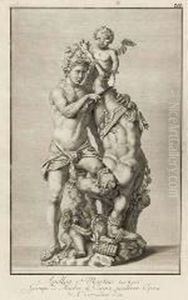Georg Martin Preissler Paintings
Georg Martin Preissler was a prominent German engraver born in 1700 in Nuremberg, a city with a rich tradition in the arts, particularly printmaking and engraving. He came from a family of artists, which included his father, Johann Daniel Preissler, who was a painter and illustrator, and his siblings, who also pursued careers in the arts. This familial environment provided Georg Martin with an early exposure to artistic training and practice.
Preissler initially received instruction from his father and later possibly worked with other local engravers to refine his skills. He became known for his fine line engravings, which displayed a high level of detail and precision. His works often depicted religious subjects, portraits, landscapes, and allegorical scenes, reflecting the tastes and interests of the period.
Throughout his career, Preissler contributed to the dissemination of artistic knowledge by reproducing the works of well-known artists of his time and earlier periods. This was a common practice among engravers, who played a crucial role in the spread of artistic styles and ideas across Europe. His engravings served not only as artworks in their own right but also as a means for people to engage with images that they might not have the opportunity to see in person.
Preissler's work was characterized by the use of clear, delicate lines and attention to detail, which helped to establish his reputation. He was part of the larger Preissler family of artists, which included several generations of painters, engravers, and other craftsmen, contributing to the artistic legacy of the Nuremberg region.
Georg Martin Preissler passed away in 1754, leaving behind a body of work that was appreciated for its technical skill and artistic beauty. His engravings remain a testament to the mastery of printmaking in the 18th century and provide insight into the visual culture of the time. While he may not be as widely known today as some of his contemporaries, Preissler's contributions to the field of engraving continue to be recognized by art historians and collectors of prints.
